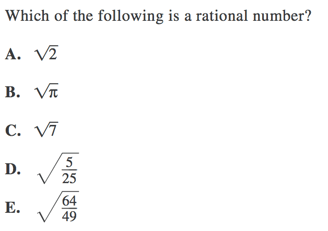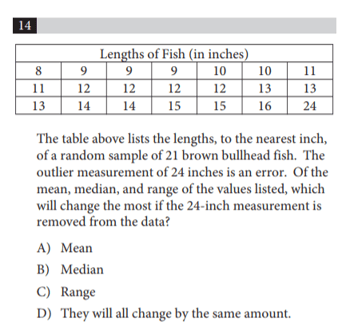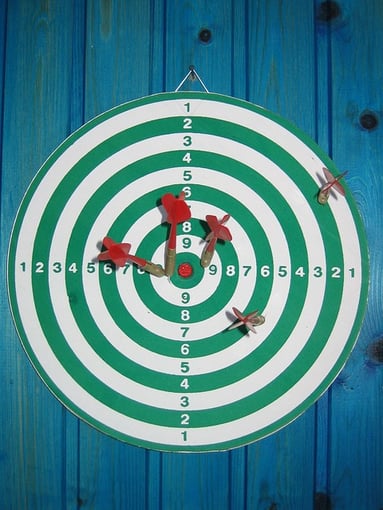
Which is better/easier/faster—the SAT Math section or the ACT Math section? How does each stack up over the course of the entire test? Most importantly, which math section is right for you?
We’ll break down both the similarities and differences in this SAT Math vs ACT Math guide and help you decide which standardized test suits you better.
SAT Math vs ACT Math: Test Organization
First, let us look at how each test is structured as a whole and how each math section fits into that overall form.
ACT Test Organization
The ACT is broken into four sections (five, if you take the ACT + Writing), making for a two-hour and 55-minute test (or a three-hour and 35-minute test), not including break times. Each topic section is taken all at once, meaning they are not broken into smaller subsections, and the topics will always appear in the same order.
Here is an overview of the ACT Math section:
| ACT Section | Order on Test | # of Questions | Total Time | Time per Question |
| Math | 2 (after English) | 60 | 60 mins | 60 sec |
The ACT Math section will always be the second section and therefore will always be sandwiched between ACT English and ACT Reading. You'll have no opportunity to come back to the Math section once your time is up, so you'll have to balance your timing and strategies yourself. Even if you have an extra 10 minutes left on the Reading section, you can't come back to answer more questions on the Math section.
This kind of structure tends to appeal to those who can focus on one task for long stretches of time or those who like to finish tasks completely before moving on. The trade-off is, of course, that you'll need to be vigilant when taking the section (if, for any reason, you always get very sleepy in the second hour of taking a standardized test, there goes your entire Math score!).
SAT Test Organization
The SAT has three main sections (four if you take the SAT with Essay) that, like the ACT, will always appear in the same order. The test is a total of three hours (three hours and 50 minutes with the optional Essay), with the Math section taking up 80 minutes total. Similar to the ACT, once the Math section is over, you'll have no opportunity to go back and answer any questions you might have missed.
Here is an overview of the SAT Math section:
| SAT Math Section | Order on Test | # of Questions | Total Time | Time per Question |
| No Calculator | 3 (after Writing) | 20 | 25 mins | 75 sec |
| Calculator | 4 | 38 | 55 mins | 87 sec |
The SAT Math section is the only section on the test that's broken up into two segments: a No Calculator subsection (for which you may not use a calculator) and a Calculator subsection (for which you may use a calculator). The No Calculator section comes first after Writing and is 25 minutes long, whereas the Calculator section comes afterward and is 55 minutes long.
The SAT testing structure tends to appeal to those who feel more confident in their math abilities and don't need or want to rely on a calculator as much. You'll also get more time per question with the SAT Math section than you will with ACT Math, so it's ideal for those who'd like more time to solve problems and check their answers (we'll talk more about this in detail later).
The difference between the two test structures mostly depends on how you like to test. For some people, solving math problems without being able to check them with a calculator is a huge challenge. Others might prefer getting the math section done as early as possible.
There is no "better" test design for everyone—just the one that appeals to you more or works better for you specifically.
 Each test will always have its own predictable structure so there will never be any surprises.
Each test will always have its own predictable structure so there will never be any surprises.
SAT Math and ACT Math: Question Types
Although many of the math topics covered by the SAT Math section and the math topics covered by the ACT Math section are the same or similar (with some notable exceptions—we'll talk about this more in a moment), the way each test presents its questions is markedly different.
Now that we've seen how each exam is organized, let's look at the type and presentation of each math question on the SAT and ACT.
ACT Math Question Types
The ACT tends to present math questions in a fairly straightforward manner. The questions may test you on challenging mathematical concepts, but they are not specifically designed to test your reading comprehension, nor are they set up to lure you to select bait answers.
Basically, ACT Math questions test how well you have memorized a particular math concept and whether you can appropriately recognize and utilize it when necessary.
Again, this is not to say that ACT Math questions are easy—many of them are quite challenging—but they're designed to test how well you know specific math concepts and not how well you can solve a puzzle you've never seen before, or how well you can translate a long paragraph that sets up an unusual math scenario.
For example:
Do you know what a rational number is?

And:
Do you know how to find the tangent or cosine of a particular angle?

(For answers and step-by-step tips on how to solve these questions, check out our guide to the hardest ACT Math questions.)
Note that each question gives you five answer choices, so you will always have a 20% chance of getting a question right, even if you were to just venture a guess.
You will not be provided with any formulas on the test, so you must have them all memorized before test day. (For a complete list of formulas to know for the ACT, check out our guide to the 31 formulas you'll need to memorize.)
Compared to the SAT, the ACT covers a slightly wider range of math topics, such as graphs of trig functions, matrices, and logarithms, none of which is on the SAT. But you must only memorize a few specific rules and formulas for each topic.
In addition, geometry makes up about 35-40% of ACT Math but a far smaller percentage of SAT Math, so if you're really good at geometry, the ACT might work better for you.
Essentially, the ACT casts a wider mathematical net than the SAT does, but each topic is covered a little more shallowly (except for geometry).
SAT Math Question Types
The SAT Math section is very similar to the ACT Math section in that questions generally test the same broad math topics (with a large emphasis on algebra) and are all fairly straightforward.
In terms of content, the SAT has a much smaller focus on geometry than the ACT does (less than 10% of SAT Math is geometry questions).
Furthermore, SAT Math tests fewer math concepts as a whole. While the ACT has slightly more questions that deal with trigonometry, the SAT only has a few at most, so if you're not really good with sines, cosines, and tangents, the SAT might be a better fit for you.
The SAT Math section does have a large emphasis on word problems and data analysis, more so than the ACT Math section does. The data analysis problems are often connected across many questions as well.
For example:
Can you understand how algebra relates to a real-life scenario?

And:
Do you know how to interpret tables and charts?

In terms of formulas and necessary information, the SAT will always give you a formula box at the beginning of both the No Calculator and Calculator sections. Despite this, we still suggest making time to memorize the most important formulas so there are no surprises on test day.
Another big difference from the ACT Math section is that the SAT Math section has 13 grid-ins, or student-produced response questions, which account for a whopping 22% of questions on SAT Math. For these, you must come up with your own answer to a problem—there are no answer choices to choose from!
Finally, as you could probably tell from the examples above, multiple-choice SAT Math questions will always have just four answer choices as opposed to the ACT's five answer choices. This gives you a slightly better chance (25%) of getting a question right if you were to guess.
Each test gives you a slightly different array of math topics and problems, but, once again, there is no "better" test for everyone. If you are stronger in geometry and want to always have access to a calculator, then the ACT might be a better fit. On the other hand, if you like connected data analysis problems and are confident in your math abilities without a calculator, then the SAT might be the ideal exam for you.
So let's talk scores (and hopefully none of us will be the throw on the top right).
ACT Math vs SAT Math: Scoring
For both the ACT and SAT, the balance of correct and incorrect answers gives you what is called a raw score, which is converted into a scaled score. Let’s break down this process and look at how each test differs in its scoring approach.
ACT Scoring
The entire ACT Math section is multiple choice with five different answer options. For each question on the ACT, you will earn the following points:
-
+1 raw point for each correct answer
-
0 raw points for any incorrect or blank answer
There is no penalty or negative points for wrong answers on the ACT.
Once you have a raw score, you can convert it into a scaled score out of 36. This scaled score, in turn, will show you how you rank nationally in terms of your percentile, which indicates how you compare with other students who took the test.
For example, if you scored in the 60th percentile, you scored better than 60% of all students who took the test (and 40% of all students received a higher score than you).
For details on how to find your raw score, scaled score, and percentile, read our guides on how the ACT is scored and ACT percentiles and score rankings.
SAT Scoring
As we explained earlier, the SAT Math section is broken into a combination of multiple-choice and grid-in questions. For each question, you will receive the following:
-
+1 raw point for each correct answer
-
0 raw points for any blank answer
Like with the ACT, there is no point penalty for incorrect or blank answers on the SAT.
The total raw score on the SAT Math section gets converted into a scaled score on a scale of 200-800. This scaled score will, in turn, give you your percentile ranking, which compares your scaled score to everyone else who took the SAT.
To learn more about how to find your raw score, scaled score, and percentile, take a look at our guides on how the SAT is scored and SAT percentiles and score rankings.
ACT Scores and Percentiles vs SAT Scores and Percentiles
(Note that these are general estimates for the raw score needed to get a certain scaled score on SAT and ACT Math. In reality, the exact raw score you'll need to get a certain scaled score differs a little with each test to account for differences in question content and difficulty.)
|
ACT Raw Score |
ACT Scaled Score |
ACT Percent Questions Correct |
ACT Percentiles |
| 16-18 | 16 | 27-30% |
25th percentile |
| 25-26 | 19 | 42-43% |
50th percentile |
| 34-36 | 24 | 57-60% |
75th percentile |
| 49-50 | 30 | 82-83% |
95th percentile |
|
SAT Raw Score |
SAT Scaled Score |
SAT Percent Questions Correct |
SAT Percentiles |
| 20 | 450 | 34% |
25th percentile |
| 28 | 520 | 48% |
50th percentile |
| 39 | 600 | 67% |
75th percentile |
| 52 | 730 | 90% |
95th percentile |
As you can see, to get the same percentile on the ACT and SAT Math sections, you'd need to get a few more questions right on the SAT than you would on the ACT. For example, to get in the 95th percentile, you'd need to get around 52 questions right on the SAT Math section but only 49 or 50 questions right on the ACT Math section.
For more tips on how to strategically select your answers for each test and generate the highest score, check out our guides on how to best guess on the SAT and how to best guess on the ACT.
ACT Math and SAT Math: Time Per Question
Now, let's look at how the time constraints for the ACT and SAT stack up against each other.
ACT Timing
The ACT gives you 60 Math questions to answer in 60 minutes, which gives you an average of 60 seconds per question.
Remember, too, that the ACT also tests your mathematical stamina a little more so than the SAT does: unlike the SAT, which separates Math into two subsections (No Calculator and Calculator), the ACT gives you all 60 Math questions at once, with no break in-between.
SAT Timing
The SAT Math section is divided into two subsections (No Calculator followed by Calculator), each of which has its own number of questions and time constraint:
| SAT Math Section | # of Questions | Total Time | Time per Question |
| No Calculator | 20 | 25 mins | 75 sec |
| Calculator | 38 | 55 mins | 87 sec |
Note that there is a short five-minute break between the No Calculator and Calculator sections, so you're not actually solving all these questions at once as you are on the ACT!
As you can see, compared to the ACT, the SAT gives you a little more time per question on Math. You'll typically have anywhere from 15 to 27 seconds more per question on SAT Math than you would on ACT Math.
If you're worried about having enough time for each math question, the SAT would probably be a better option for you.
 "And so the problem remained; lots of people were mean, and most were miserable, even the ones with digital watches." — Douglas Adams (Probably because digital watches are not recommended for the SAT or ACT!)
"And so the problem remained; lots of people were mean, and most were miserable, even the ones with digital watches." — Douglas Adams (Probably because digital watches are not recommended for the SAT or ACT!)
Summary: SAT Math vs ACT Math
To more easily see the two tests compared side-by-side, let us recap.
The ACT Math section has the following characteristics:
- Appears second on the ACT, directly after English
- Contains two more math questions than the SAT does (60 total compared to 58)
- Is only one section, which allows you to use a calculator throughout as needed
- Gives you an average of 60 seconds per question
- Does not issue a wrong-answer penalty
- Is entirely multiple choice, with every question having five possible answer choices
- Will not provide you with any formulas
- Tests a slightly wider variety of math topics than the SAT does
- Has a much larger emphasis on geometry than the SAT does
The SAT Math section, meanwhile, has the following characteristics:
- Appears third on the SAT, directly after Writing and Language
- Has two less questions than ACT Math does (58 total compared to 60)
- Is broken up into two subsections: No Calculator and Calculator
- Gives you an average of 75-87 seconds per question
- Does not issue a wrong-answer penalty
- Consists of a combination of multiple-choice and grid-in questions
- Has four answer choices for each multiple-choice question
- Will provide you with a box of formulas before each subsection
- Tests slightly fewer math topics than the ACT does
- Has more emphasis on data analysis and word problems than the ACT does
Everyone will weigh their pros and cons differently. Don't judge your scale against anyone else's—your choice is ultimately up to you.
ACT Math vs SAT Math: Which Test Is Better for You?
Unfortunately, you won’t know which test you like better or which test suits your strengths unless you actually sit down and take a practice test of each (you can find free practice SAT tests and free practice ACT tests here). Take each complete test with the proper timing rules and then score your results (SAT scoring guides and ACT scoring guides).
If the difference in your scores is huge (you can use current percentiles to get a feel for how "good" your scores are), you have a clear front-runner. If not, go with your gut or whichever test felt more comfortable for you. Colleges do not prefer one test over the other, so the choice is completely dependent on how you like to test.
Although it might sound extreme to take two lengthy tests in your spare time, it's well worth it to find the right test for you. Think of it this way—If you’re going to dedicate the necessary hours to succeed (and we recommend that you study around 40 hours total!), then you might as well spend the first few of them figuring out which test you feel more comfortable with.
It'd certainly be a waste of your time and effort if you spent 40 hours studying for the ACT only to decide that you actually like the SAT better!
Taking a real practice test will also help you set realistic study and scoring goals, and help you figure out how to make the best use of your time, both before and during the test. Once you find your raw and scaled scores, you can start the process of setting realistic goal milestones until you get your score to where you want it to be.

If your standardized test of choice is your big boss fight, it's best to pick the one you can soundly thrash.
The Takeaways: Should You Take SAT Math or ACT Math?
Again, there is no one true "better" test—only the test that better fits your own strengths and preferences. Once you take a practice test for both the ACT and the SAT and examine your scores and your feelings while taking each, you'll be able to clearly decide how to proceed.
Remember that you must weigh the pros and cons of each Math section against the entire test as a whole. If you like the SAT Math section better but do a lot better on the ACT as a whole, then you must make the decision about whether your comfort level and Math score are more important than your score on the entire test.
Standardized testing is all about balance, so take time to weigh your pros and cons carefully. And once you do this, only practice and diligence will help you strike that perfect balance and achieve your greatest testing potential.
What’s Next?
Want to compare the ACT vs the SAT across the whole test? Check out our complete ACT vs SAT guide to learn more about the nuanced differences between the two exams.
Ready to make an SAT/ACT study plan? First figure out how long you should study for the ACT and how long you should study for the SAT.
Running out of time on the ACT or SAT Math section? If you took a practice test but couldn't finish it in time, then check out our tips for how stop running out of time on ACT Math and SAT Math.
Looking to get a perfect score? Our guides to getting a 36 on ACT Math and getting an 800 on SAT Math (both written by a perfect scorer!) will help get you where you need to be.
Want to improve your SAT score by 160 points or your ACT score by 4 points? We've written a guide for each test about the top 5 strategies you must be using to have a shot at improving your score. Download it for free now:
Have friends who also need help with test prep? Share this article!

Courtney scored in the 99th percentile on the SAT in high school and went on to graduate from Stanford University with a degree in Cultural and Social Anthropology. She is passionate about bringing education and the tools to succeed to students from all backgrounds and walks of life, as she believes open education is one of the great societal equalizers. She has years of tutoring experience and writes creative works in her free time.





































 Holly R.
Holly R.